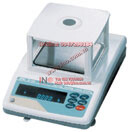The SR540 chopper will handle all your optical chopping requirements—from simple measurements to dual-beam and intermodulation experiments. The SR540 has a 4-digit frequency display, front-panel frequency control, analog voltage frequency control and two reference outputs with selectable operating modes.
SR540 Optical Chopper
- 4 Hz to 3.7 kHz chopping frequencies
- Low phase jitter
- Single and dual beam experiments
- Sum & difference reference outputs
- Bolt clamp or rod mounting
SR540 Optical Chopper
The SR540 chopper will handle all your optical chopping requirements—from simple measurements to dual-beam and intermodulation experiments. The SR540 has a 4-digit frequency display, front-panel frequency control, analog voltage frequency control and two reference outputs with selectable operating modes. Two anodized aluminum blades are provided: a 5/6 slot blade for frequencies up to 400 Hz, and a 25/30 slot blade for frequencies up to 3.7 kHz. Reference outputs are provided for frequencies corresponding to each row of slots, as well as the sum and difference frequencies.
Optical Chopper Applications
Single-Beam Experiment
In this application, a single optical beam is chopped by the outer row of slots, and the reference output from the right BNC is used to lock the lock-in amplifier to the chop frequency. The inner row of slots could also be used, in which case the left BNC would be the reference output. In either case, the REFERENCE MODE switch is in the “up” position.
Dual-Beam Experiment
In this arrangement, the output from a single source is split and chopped at two different frequencies by the two rows of chopper slots. One beam passes through the experiment while the other is used as a reference beam. The beams are recombined and sent to the same detector. Two lock-ins are used to detect the signals at ƒinner, corresponding to the experimental signal, and ƒouter, corresponding to the reference beam. If the detected signal in the experimental arm is ratioed to the detected signal in the control arm, then effects due to changing source intensity and detector efficiency are removed.























